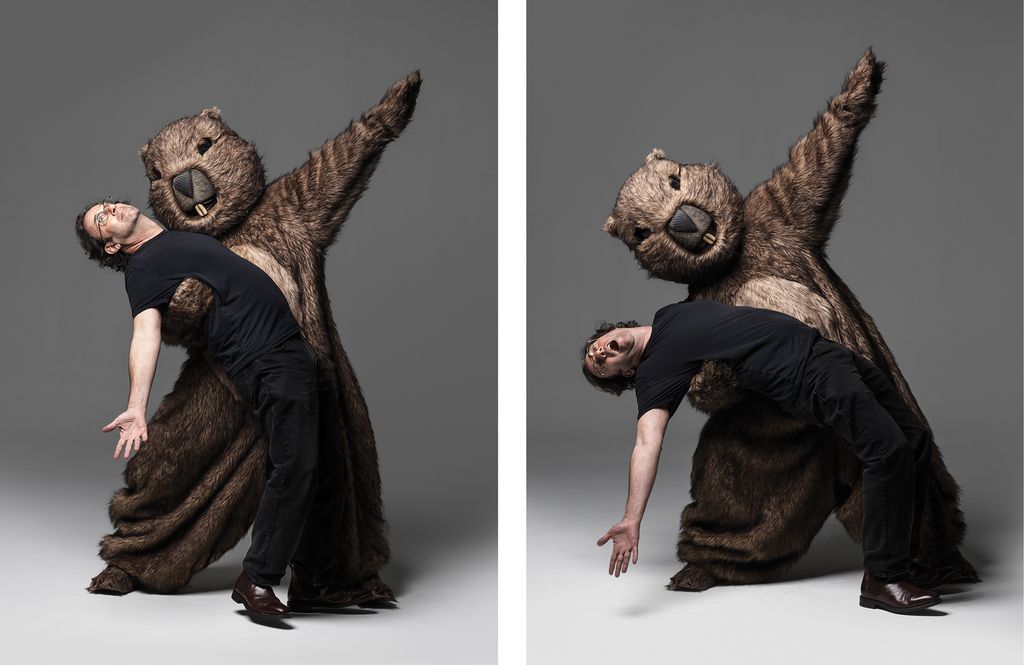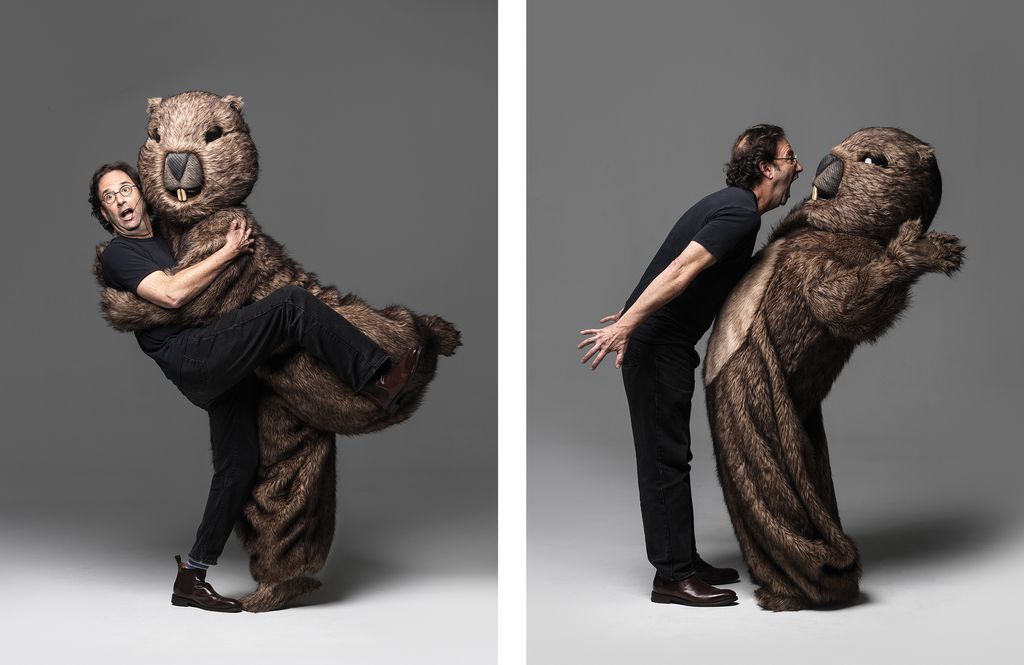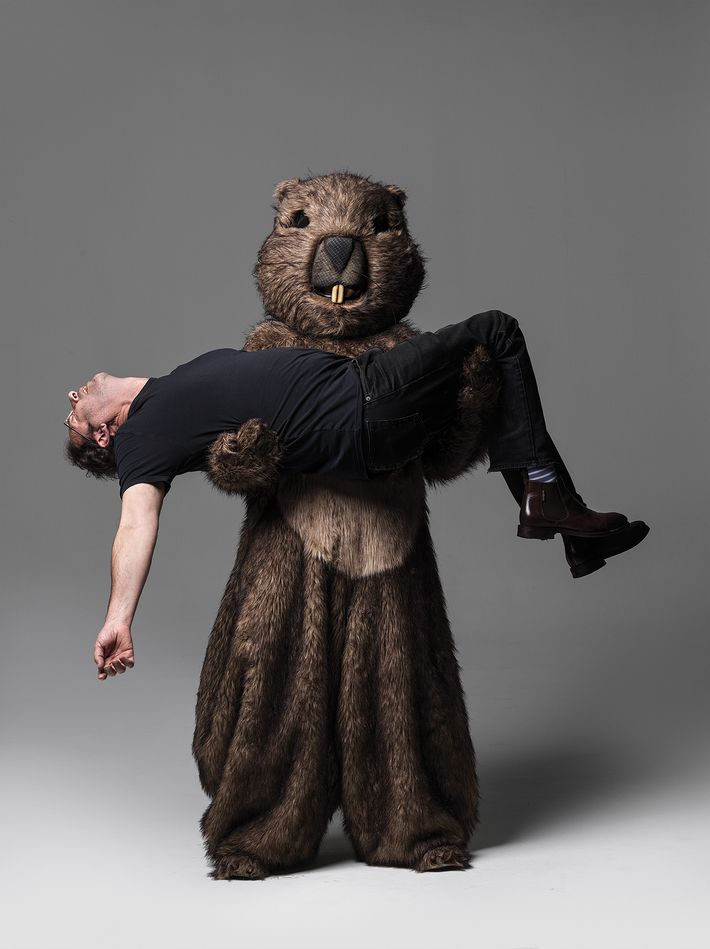On the first night of previews for Groundhog Day the musical, as the lights go down, it’s safe to say that most of the audience already knows the story that’s about to unfold. It would be hard to find anyone who hasn’t seen, or osmotically absorbed, the 1993 Bill Murray film on which this show is based, the story of a cynical weatherman trapped in a single repeating day.
But no one knows it as well as the guy in the third row: a 60-year-old with wild wisps of hair, round eyeglasses, and a Hopi-sun-symbol stud in one ear. Danny Rubin is utterly rapt, even though he’s seen this performance more than 20 times; even though he’s lived with this story for nearly 25 years; even though he’s listening to some of the same lines he first tapped out on a Toshiba laptop when he was a young man of 32.
Rubin is the guy who wrote Groundhog Day the musical. He’s also the guy who wrote Groundhog Day the film — both the original script and the version he later hammered out with director Harold Ramis.
It’s still the film he’s still best known for; in fact, to this day, it’s the only film he’s known for. If you look him up on imdb.com, there are just four writing credits to his name. One of them is the story credit for the Italian remake of Groundhog Day (“Stork Day”). Two others are screenplays for a 1993 Marlee Matlin thriller and a 1994 film called S.F.W. that enjoys a solid 12 percent rating on Rotten Tomatoes. The fourth credit is Groundhog Day — a film so beloved, idiomized, and dissertated about that it’s passed into English vernacular. For almost 25 years, that lone film has remained, for good or ill, his calling card.
“I’m the guy who wrote Groundhog Day,” he says now. “I’m not the amazing screenwriter who’s had this long and storied career. I’m not Tom Stoppard.” But if you have to be stuck with one movie, it could be a worse movie than Groundhog Day. “It’s delightful to be so associated with something so well loved,” Rubin says. “You could break your heart thinking you’re the victim of this amazing life you’ve got.”
This is the story of how Danny Rubin wrote Groundhog Day not once but twice — maybe more times than that, but who’s counting. It’s unusual for any artist to live so long under the shadow of a single work, let alone a story that is itself intimately concerned with limits and repetition. It’s more unusual still for an artist to return to that story in another medium for an encore nearly three decades later. Yet here Rubin is, in a Broadway theater, listening to his words echo, again and again and again, into the dark.
He doesn’t remember how the idea first came to him. Rubin gets ideas the way some people take drugs — in wee fistfuls. When this particular batch hit him, he wrote down ten of the best ones in a list.
It was the late ’80s, and Rubin was living in Chicago, turning out scripts for industrial films. He once spent two days working the front counter of the country’s most productive McDonald’s so he could write a video showing other McDonald’s workers how to shave seconds off their time with each customer. It wasn’t glorious, but at least he was being paid for writing.

Still, he wanted to try writing real screenplays. So he made a list of his ten best ideas. Idea No. 2 was a Hitchcockian thriller about a murder in the deaf community; he called it Silencer. An agent got interested and that script sold, and a version of it eventually became the decidedly un-Hitchcockian Marlee Matlin vehicle Hear No Evil. Rubin moved his family to L.A.
His agent said, “Get me a writing sample,” so Rubin went back to his list. Idea No. 10 on the list was “A man lives the same day over and over.” He wasn’t the first to think of this premise. The idea of reiterating the same stretch of time goes at least as far back as a 1904 short story by a British military strategist, in which a man dreams his way through the same battle, again and again. In 1973, an American named Richard A. Lupoff published a short book titled 12:01 P.M. about a man stuck in a “disfiguration of time.” (Lupoff briefly pursued legal action against Columbia Pictures after Groundhog Day came out, but the lawsuit was never formally filed.)
Rubin had never read either of these, and he didn’t care how his protagonist had come to be trapped in February 2 — a date he chose in the hope that the movie might become a holiday cable perennial, the way It’s a Wonderful Life was broadcast every Christmas. Rubin was more interested in what would happen to a man stuck reliving the same day over and over. Would he go crazy? Fall to his worst impulses? How many lifetimes would it take for someone to truly change?
He thought about the possibilities for a while. Then he powered through drafting the script in four days and sent it off to his agent. Ramis, who wrote and co-starred in Ghostbusters, found the script and was hired to direct it, and he cast Bill Murray to star in it. Rubin spent weeks revising it, first with Ramis, then with Murray — the two of them throwing ideas back and forth, hanging out in Punxsutawney, Pennsylvania — and then it went back to Ramis, who defended it from the studio’s worst impulses, such as inserting a scene where the main character, Phil Connors, gets cursed by a gypsy. Then they filmed it, and it was a hit.
For Rubin, working with Ramis and Murray wasn’t intimidating as much as reassuring: It felt like Hollywood had recognized him for who he was, like it had realized what he could do.
“It was like, ‘Finally,’ ” he says now. “ ‘This is where I belong.’ ”
And then it never happened again.
After the film Groundhog Day was a success, Rubin started getting calls to work on scripts. He was now a known quantity — he was the guy who wrote Groundhog Day — and all producers seemingly wanted was for him to write the same movie again. A rom-com. Something quirky. But not too quirky. Maybe something with a time warp or a weatherman.
“They’d say, ‘Just write something normal and it’ll come out Danny Rubin–y. It’ll be great,’ ” he says. “But I don’t want to write something normal! It’s messing with the premise and the structure that makes it exciting!”
It didn’t help that he’d moved his family to Santa Fe, New Mexico, before Groundhog Day had even finished shooting. At first, L.A. tried to woo him back, regularly flying him into town. Rubin’s brother Michael, who also worked in Hollywood, knew how this was supposed to go: “They want to meet you for lunch at the Ivy and they want to think you’re a totally fun guy,” he says. “You get in the door because you wrote a hit movie, but they want to see you as a guy they can play with.” But Rubin wouldn’t play.
“It would be like, Goldie Hawn has a dysfunctional family, none of them get along, so they go camping and in the end they all learn to love each other,” Rubin recalls. “Typically I would say, ‘Okay, I am going to tell you your movie.’ ” He’d lay out a perfectly respectable studio picture, with a three-act structure and a conventional conclusion. “And then I’d say, ‘Under no circumstances am I going to write that movie.’ ” He sighs. “It took me years to understand that’s why the business started disappearing.”
Most people in this situation either quit the screenplay business or learn to compromise. Rubin did neither. He kept writing scripts for his own ideas, and he kept selling them, pretty steadily, over the years — to Universal, to Amblin, to Castle Rock, to Miramax. But none of them were produced, and even when one of them spent some time being developed, Rubin would often be booted off the project. He wrote a movie about a woman; they asked if it could be about a man. He wrote a silent film; they asked if it could have dialogue. “People weren’t responding to my stuff by making movies out of it,” he says. “They were optioning it, but then there were the same arguments over and over: They were trying to make a movie I said I was expressly not interested in making.”
Tim Minchin, who composed the songs for Groundhog Day the musical, puts it more succinctly: Rubin, he says, “refused to write to their fucking specs.”
Rubin’s daughter, Maida, was a kid back then, but she remembers her dad’s Hollywood travails. “It seemed true of all his projects that they would take out the part he found interesting,” she says. “They just wanted it to be more like something they already knew.”
Even as Rubin continued to not make films, Groundhog Day became a proportionally bigger and bigger part of his résumé — and of pop culture at large.

The film had been a solid success when it came out but not a phenomenon; Roger Ebert gave it three stars. But as years passed, it seemed to gain resonance. The idea of a time loop became a standard trope in movies and television, and the term “Groundhog Day” itself became vernacular for any experience that seemed endlessly to repeat. Rubin’s friends would call him up excitedly whenever they heard someone use it, until it became so common that they had to stop.
People kept writing to Rubin to tell him what his movie was about. A monk saw it as a Christian allegory; a Kabbalist analyzed the significance of its numerology. Philosophy students wrote dissertations about Groundhog Day and Nietzsche’s concept of the “eternal recurrence.” An economist published a column claiming that the film “illustrates the importance of the Mises-Hayek paradigm as an alternative to equilibrium economics by illustrating the unreal nature of equilibrium theorizing.” Addicts told Rubin that the film had helped them realize they were trapped in Punxsutawneys of their own making.
The letters and phone calls and emails would reach a crescendo every February 2, a day when Rubin would hear not only from strangers and fans but from his own friends and family. Someone — he never found out who — for years left him little presents, balloons or candy or a toy groundhog, on his porch in Santa Fe. “It’s like my birthday,” he says.
You could imagine a version of this story in which Rubin is bitter. “He’s got every reason to have an antagonistic relationship with this beast,” says Matthew Warchus, who directed the musical. Minchin agrees: “One can assume that, Groundhog Day being so far and away his greatest success, it would cast a huge shadow over him,” he says. Rubin himself will concede only the slightest negativity. “I was always thinking, I’m not a one-hit wonder, I’m not a one-hit wonder!” he says. Then he laughs. “But even if I am — okay, that’s more than most people get.”
At some point, he started leaning into it. In 2005, Ebert published a new review of Groundhog Day, upgrading it to four stars. In 2007, Rubin started a blog — Blogus Groundhogus — where he answered questions from fans and posted fictional dialogues between himself and Phil Connors, now retired from the weather business and living on a mountainside near Taos. At his brother’s suggestion, he published an ebook on screenwriting, called How to Write “Groundhog Day.” He ended up teaching screenwriting at Harvard for five years.
Every year, when February 2 came around, he and his wife would invite over all their friends, push back the furniture, and dance.
But the story does not end there, because it is also a love story. That’s where Minchin and Warchus come in.
In 2012, they were fresh off the success of their first musical, Matilda, and they wanted Groundhog Day to be their next adaptation. Warchus knew that Rubin had been tinkering with a musical version of the film for years (partly for fun; partly because that was one of the rights he hadn’t signed away to Columbia Pictures). But they had a hunch that Rubin had to be approached cautiously.
“We just knew, obviously, this story is incredibly important to Danny,” Minchin says. “He wasn’t going to trust just anyone with his baby.”
Minchin, a musician and stand-up comedian from Australia, made his name performing in bare feet and mascara, and in Rubin he immediately recognized a fellow eccentric. “He’s a beautiful guy and a one-in-a-trillion really,” Minchin says. “He’s an incredibly gentle, sensitive guy, too good for the world he ended up in, too pure in his desire to write interesting things for Hollywood.”

So they courted him. Warchus flew Rubin to London to see Matilda. Then he and Minchin collaborated speculatively with Rubin on the musical for years without asking for the rights, on the basis of a handshake.
Minchin noticed that Rubin sometimes made jokes that didn’t seem funny. “Like joking comments that tell the truth,” Minchin says, “About how ‘You’ll just fire me off the project anyway’ — because that happens in Hollywood quite a lot.” Minchin got the sense that Rubin had been hurt by years of “having people slightly fuck with him.”
Finally, he says, he took Rubin aside. “I said, ‘Danny, look at me: Sometime in the future soon, in the next two years, this will be onstage. And you will be sitting next to me, watching what we made together. That’s what’s going to happen. So you have to trust me that you’re going to be there, of course, because it’s yours … you’re going to be there if you like it or not.’
“And that was the last time he made those jokes,” Minchin says.
In August 2016, the musical opened in London to mostly rave reviews. For Rubin, the process of writing Groundhog Day for the second (maybe third?) time was a kind of vindication, a do-over. Where Hollywood had mostly disposed of him by the time shooting began on the film, Minchin and Warchus saw him as a vital component all the way through workshops, rehearsals, and opening night.
“In theater, the writer is supposed to be a participant. In fact, the writer is a primary participant,” Rubin says. “So if you’re a writer who’s spent 20 years being sidelined, to be allowed to be at the big-boy table — it was very satisfying.”
“He’s really getting another chance,” his brother Michael says. “He is Phil! Go figure, he has made it, he’s lived through that, and he’s a better person and a cooler guy.”
“It’s ironic, of course,” Minchin says, “that for him, it has come round again and he has to relive this, has to relive this story of reliving stories.”
Something has happened. It’s about 15 minutes into the first preview show, and the actors have suddenly vanished from the stage. The audience murmurs. The curtain drops. Minutes go by in silence.
Finally, Warchus comes out to make an announcement: Inside the stage, the complex mechanism that powers the production’s intricate onstage turntables — there are five of them, nestled within each other — has somehow broken down. It’s never happened before, and they don’t know how to fix it. The rest of the musical will be performed with the cast sitting on the stage in a row of chairs, and everyone in the audience will get tickets to a second show.
The audience is, if anything, a little bit thrilled. The usual has been disrupted. They’re witnessing a one-off, an iteration of Groundhog Day that will never happen this way again. They’re now complicit in show-business history. When the evening ends, the cast is given a standing ovation.
As for Rubin, he’s smiling, beatific. “What a triumph,” a stranger says to him. His friends hug him. The technical breakdown doesn’t bother him much; he’s not an easily bothered guy.
The one screenplay he wrote that he most wishes someone would make is called The Hanging Tale. It’s a Scheherezade Western: A man is on the verge of being hanged, and they ask him for his final words. He starts telling a story — the story becomes the bulk of the film, “full of adventures and cliffhangers,” Rubin said. “And then you cut back to the hanging and it’s night now and he’s still standing there with the noose around his neck, and they ask, ‘What next?’ ”
Eventually, the townsfolk postpone the hanging again and again, “until the story he’s telling teaches the town compassion and they let him go.”
If the musical is a success, Rubin thinks, maybe he’ll get a little heat off it. Maybe he’ll be able to see one more screenplay produced. That would be something. Who knows?
“I sometimes think he’s watched the story and adopted some of its wisdom,” Warchus muses about Rubin. “He’s understood what was in his story and really taken it to heart. It’s like he threw himself a lifeline 20 years ago.”
The crowd files out into the New York night, and the guy who wrote Groundhog Day goes with them. He’ll be back to do it all again tomorrow.
Grooming by Korey Fitzpatrick for Exclusive Artists using Murad Skin care.
*This article appears in the April 3, 2017, issue of New York Magazine.